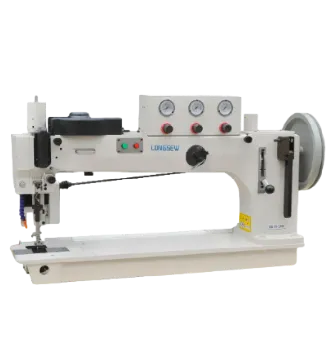typical double needle sewing machine
Understanding the Typical Double Needle Sewing Machine
The double needle sewing machine is an indispensable tool in the world of textile manufacturing and garment production. This specialized sewing machine is designed to operate with two needles simultaneously, offering a unique set of features and functionalities that are particularly advantageous for specific applications. Understanding the typical double needle sewing machine can provide valuable insights into its purposes, advantages, and operating mechanisms.
At its core, a double needle sewing machine functions much like a traditional single needle sewing machine. However, it is equipped with two needles that move in tandem, allowing for the sewing of two parallel seams at once. This design is particularly beneficial for creating decorative stitches or for reinforcing seams in fabrics where extra durability is desired. Common applications include sewing hems on garments, constructing quilted materials, and producing intricate patterns on various fabric types.
One of the primary advantages of using a double needle machine is the time efficiency it offers. In conventional sewing, creating multiple seams or decorative stitches can be a time-consuming process that requires multiple passes with a single needle machine. In contrast, the double needle allows sewers to complete these tasks in a single pass, effectively doubling productivity. This feature is crucial in commercial environments where time is money.
typical double needle sewing machine

Moreover, the double needle sewing machine provides a distinct aesthetic advantage. The ability to sew two lines of stitching simultaneously not only reinforces the seam but also adds a professional touch to the finished product. Many garment manufacturers utilize double needle machines to achieve a high-quality appearance, particularly on items like shirts, leggings, and other apparel that require a polished look. The parallel stitches create visual interest, enhancing the overall design.
In terms of operation, using a double needle sewing machine requires some adjustments compared to a standard machine. It typically includes two separate needle positions, which may necessitate specific needle types and thicknesses, depending on the fabric being used. Additionally, the presser foot and feed mechanism may need to be adjusted to accommodate the two needles, ensuring smooth and even stitching. While initially, it might seem complex, once mastered, it opens up a wide range of creative possibilities.
However, certain limitations exist with double needle sewing machines. The primary constraint is that these machines can only sew straight stitches, which may limit their versatility compared to multi-functional sewing machines. Additionally, the lack of backward stitching is a consideration, as sewers must plan their work to ensure that stitches remain secure.
In conclusion, the typical double needle sewing machine is a powerful asset for those in the sewing and garment manufacturing industries. Its ability to stitch two lines simultaneously not only enhances efficiency but also elevates the final product's appearance. While it may require some adjustments and knowledge to operate effectively, the benefits it provides make it a worthy investment for both amateur and professional sewers alike. Whether it's for simple alterations or intricate designs, the double needle sewing machine remains a vital component of modern sewing practices.
-
Industrial Cylinder Arm Sewing Machine: Revolutionizing Heavy-Duty SewingNewsJul.28,2025
-
Cylinder Arm Sewing Machine: Perfect for Special Sewing ApplicationsNewsJul.28,2025
-
Cylinder Bed Sewing Machine: Essential for Sewing Complex MaterialsNewsJul.28,2025
-
Heavy Duty Sewing Machine: The Essential Tool for Industrial ApplicationsNewsJul.28,2025
-
Computerized Pattern Sewing Machine: Revolutionizing Precision StitchingNewsJul.28,2025
-
Heavy Duty Industrial Sewing Machine: Power Meets PrecisionNewsJul.28,2025
-
Leather Sewing Machine: The Industrial Standard for Tough MaterialsNewsJul.18,2025





























